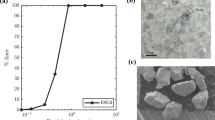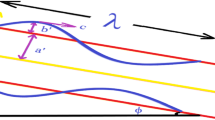Abstract
A three-dimensional model for non-reactive solute transport in physically homogeneous subsurface porous media is presented. The model involves solution of the advection-dispersion equation, which additionally considered temporally dependent dispersion. The model also account for a uniform flow field, first-order decay which is inversely proportional to the dispersion coefficient and retardation factor. Porous media with semi-infinite domain is considered. Initially, the space domain is not solute free. Analytical solutions are obtained for uniform and varying pulse-type input source conditions. The governing solute transport equation is solved analytically by employing Laplace transformation technique (LTT). The solutions are illustrated and the behavior of solute transport may be observed for different values of retardation factor, for which simpler models that account for solute adsorption through a retardation factor may yield a misleading assessment of solute transport in ‘‘hydrologically sensitive’’ subsurface environments.




Similar content being viewed by others
References
Al-Niami ANS, Rushton KR (1977) Analysis of flow against dispersion in porous media. J Hydrol 33:87–97
Aral MM, Liao B (1996) Analytical solutions for two-dimensional transport equation with time-dependent dispersion coefficients. J Hydrol Eng 1(1):20–32
Banks, Robert B, Jerasate S (1962) Dispersion in unsteady porous media flow. J Hydraul Div HY3:1–21
Batu V (1987) Introduction of the stream function concept to the analysis of hydrodynamic dispersion in porous media. Water Resour Res 23(7):1175–1184
Bruch JC (1970) Two dimensional dispersion experiments in a porous medium. Water Resour Res 6:791–800
Chen JS, Liu CW, Liao CM (2003) Two-dimensional Laplace-transformed power series solution for solute transport in a radially convergent flow field. Adv Water Resour 26:1113–1124
Chrysikopoulos CV, Voudrias EA, Fyrillas MM (1994) Modeling of contaminant transport resulting from dissolution of nonaqueous phase liquid pools in saturated porous media. Transp Porous Med 16:125–145
Cirpka OA, Valocchi AJ (2009) Reply to comments on “Two-dimensional concentration distribution for mixing-controlled bioreactive transport in steady state” by H. Shao et al. Adv Water Resour 32(2):298–301
Costa CP, Vilhena MT, Moreira DM, Tirabassi T (2006) Semi-analytical solution of the steady three-dimensional advection-diffusion equation in the planetary boundary layer. Atmos Environ 40:5659–5669
Crank J (1975) The mathematics of diffusion, 2nd edn. Oxford Univ Press, London
Diersch HJ, Prochnow D, Thiele M (1984) Finite-element analysis of dispersion––affected saltwater upconing below a pumping well. Appl Math Model 8(5):305–312
Gershon ND, Nir A (1969) Effects of boundary conditions of models on tracer distribution in flow through porous mediums. Water Resour Res 5(4):830–839
Harleman DRF, Rumer RR (1963) Longitudinal and lateral dispersion in an isotropic porous medium. J Fluid Mech 16(3):385–394
Jaiswal DK, Kumar A, Kumar N, Yadava RR (2009) Analytical solutions for temporally and spatially dependent solute dispersion of pulse type input concentration in one dimensional semi-infinite media. J Hydro Environ Res 2:254–263
Kim KY, Kim T, Kim Y, Woo NC (2007) A semi-analytical solution for groundwater responses to stream-stage variations and tidal fluctuations in a coastal aquifer. Hydrol Process 21:665–674
Kumar A, Jaiswal DK, Kumar N (2010) Analytical solutions to one-dimensional advection-diffusion with variable coefficients in semi-infinite media. J Hydrol 380(3–4):330–337
Lapidus L, Amundson NR (1952) Mathematics of adsorption in beds, VI. The effects of longitudinal diffusion in ion-exchange and chromatographic columns. J Phys Chem 56:984–988
Liao B, Aral MM (2000) Semi-analytical solution of two-dimensional sharp interface LNAPL transport models. J Contam Hydrol 44:203–221
Lin SH (1977) Non-linear adsorption in porous media with variable porosity. J Hydrol 35:235–243
Lin JS, Hildemann LM (1996) Analytical solutions of the atmospheric diffusion equation with multiple sources and height-dependent wind speed and eddy diffusivities. Atmos Environ 30(2):239–254
Liu SH, Liedl R, Grathwohl P (2010) Simple analytical solutions for oxygen transfer into anaerobic groundwater, Water Resources Research Volume: 46 Article Number: W10542 Published: OCT 29 2010
Moreira DM, Vilhena MT, Buske DE, Tirabassi T (2006) The GILTT solution of the advection-diffusion equation for an inhomogeneous and nonstationary PBL. Atmos Environ 40:3186–3194
Ogata A, Banks RB (1961) A solution of differential equation of longitudinal dispersion in porous media. US Geol Surv Prof Pap 411:A1–A7
Shao H, Centler F, Biase CD, Thullner M, Kolditz O (2009) Comments on “Two-dimensional concentration distribution for mixing-controlled bioreactive transport in steady-state” by OA Cirpka and AJ Valocchi. Adv Water Resour 32(2):293–297
Sirin H (2006) Ground water contaminant transport by nondivergence-free, unsteady and nonstationary velocity fields. J Hydrol 330:564–572
Todd DK (1980) Groundwater hydrology, 2nd edn. Wiley, New York
Tracy FT (1995) 1-D, 2-D, and 3-D analytical solutions of unsaturated flow in groundwater. J Hydrol 170:199–214
van Genuchten M Th, Alves WJ (1982) Analytical solutions of one dimensional convective-dispersive solute transport equations, United State Dept. of Agriculture, Technical Bulletin No. 1661
Zheng C, Bennett GD (2002) Applied contaminant transport modeling, 2nd edn. Wiley, New York, pp 56–57
Zoppou C, Knight JH (1999) Analytical solution of a spatially variable coefficient advection-diffusion equation in up to three dimensions. Appl Math Model 23:667–685
Acknowledgments
This study is a part of a postdoctoral fellowship of the author Dilip Kumar Jaiswal and gratefully acknowledges the financial assistance in the form of UGC, Dr. D. S. Kothari Postdoctoral Fellowship, New Delhi, India. In particular, we thank the editor-in-chief and the reviewers for their critical and detailed suggestions that helped to improve this manuscript substantially.
Author information
Authors and Affiliations
Corresponding authors
Appendix
Appendix
The conditions (12–13) in terms of new space (η) and time (T) variables may be written as
Now, introducing a new dependent variable by the following transformation
The set of Eqs. 19–21 and 11 reduced to
Applying Laplace transformation on Eqs. 23–26, we have
Thus, the general solution of Eq. 27 may be written as
Using condition 28–29 on the above solution, we get
Thus, the particular solution in the Laplacian domain may be written as
Taking inverse Laplace transform of 31, the solution of advection-dispersion solute transport for uniform pulse-type input condition may be written in terms of \( c(x,y,z,T) \) by using Eqs. 22, 10, 8 and 6.
Similarly, Eq. 15 reduces by applying the transformations 6, 8, 10 and 22
Applying Laplace transformation on Eq. 32, we may get
Now using input condition 33 in place of 28 in the general solution 30, we get
Thus, the particular solution in the Laplacian domain may be written as
Taking inverse Laplace transform of 35, the solution of advection-dispersion solute transport for varying input conditions may be written in terms of \( c(x,y,z,T) \) by using Eqs. 22, 10, 8 and 6.
Rights and permissions
About this article
Cite this article
Yadav, R.R., Jaiswal, D.K., Yadav, H.K. et al. Three-dimensional temporally dependent dispersion through porous media: analytical solution. Environ Earth Sci 65, 849–859 (2012). https://doi.org/10.1007/s12665-011-1129-2
Received:
Accepted:
Published:
Issue Date:
DOI: https://doi.org/10.1007/s12665-011-1129-2




